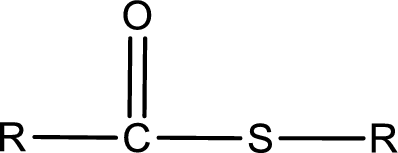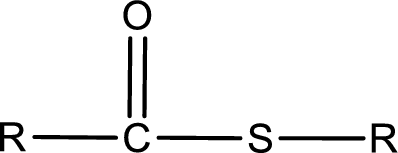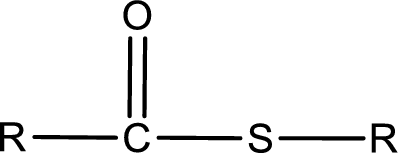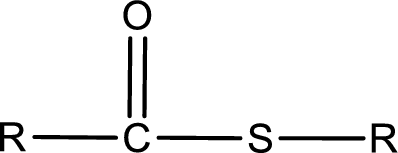
Concept explainers
(a)
Interpretation:
Structural formula for methyl thiopropanoate has to be drawn.
Concept Introduction:
General structure of thioester can be represented as shown below,

From an IUPAC name, the structure of the thioester can be derived. IUPAC name of thioester consists of two parts. In an IUPAC name of thioester, the first part of the name is the alkyl part and the second part is the acid part. Alkyl group have come from the thiol and acyl part from
The same rule applies for deriving a structure from common name. The only difference is the acyl part name. The acyl part is named using the common name of thiocarboxylic acid.
(b)
Interpretation:
Structural formula for methyl thiopropionate has to be drawn.
Concept Introduction:
General structure of thioester can be represented as shown below,

From an IUPAC name, the structure of the thioester can be derived. IUPAC name of thioester consists of two parts. In an IUPAC name of thioester, the first part of the name is the alkyl part and the second part is the acid part. Alkyl group have come from the thiol and acyl part from carboxylic acid.
The same rule applies for deriving a structure from common name. The only difference is the acyl part name. The acyl part is named using the common name of thiocarboxylic acid.
(c)
Interpretation:
Structural formula for ethyl thioacetate has to be drawn.
Concept Introduction:
General structure of thioester can be represented as shown below,

From an IUPAC name, the structure of the thioester can be derived. IUPAC name of thioester consists of two parts. In an IUPAC name of thioester, the first part of the name is the alkyl part and the second part is the acid part. Alkyl group have come from the thiol and acyl part from carboxylic acid.
The same rule applies for deriving a structure from common name. The only difference is the acyl part name. The acyl part is named using the common name of thiocarboxylic acid.
(d)
Interpretation:
Structural formula for ethyl thioethanoate has to be drawn.
Concept Introduction:
General structure of thioester can be represented as shown below,

From an IUPAC name, the structure of the thioester can be derived. IUPAC name of thioester consists of two parts. In an IUPAC name of thioester, the first part of the name is the alkyl part and the second part is the acid part. Alkyl group have come from the thiol and acyl part from carboxylic acid.
The same rule applies for deriving a structure from common name. The only difference is the acyl part name. The acyl part is named using the common name of thiocarboxylic acid.
Want to see the full answer?
Check out a sample textbook solution
Chapter 16 Solutions
General, Organic, and Biological Chemistry
- Acid hydrolysis of ------------ produces carboxylic acids. a. Cyanides b. Alcohol c. Ester d. Hydrocarbonarrow_forwardWhat kind of solvent ingredients is widely is usually used in mouthwash, perfumes and spray A. Ethly acetate B. Aliphatic alcohols C. Fragrant esters D. Phenols and phenol derivativesarrow_forwardWhat is hydrolysis of ethyl acetate? What are those example of it.arrow_forward
- What are the major products of the reaction of ethyl benzoate with hydrochloric acid and water? a. benzoic acid and ethanol b. phenylic acid and ethanol c. ethanoic acid and benzene d. acetic acid and toluene e. phenylic acid and methanolarrow_forward1. This structure will form when a hydroxyl group form a bond with a carbonyl group. a.Aldehyde b.Alcohol c.Hemiacetal d.straight chain formationarrow_forwardWhat are the major products of the reaction of ethyl benzoate with hydrochloric acid and water? a. acetic acid and toluene b. phenylic acid and ethanol C. ethanoic acid and benzene d. benzoic acid and ethanol e. phenylic acid and methanol O a O barrow_forward
- Amide hydrolysis in basic conditions forms A. a carboxylic acid and an amine B. a carboxylate salt and an amine 3. an ester and an amine 4. a carboxylic acid and an amine saltarrow_forward1. Draw the structural formula of the hemiacetal formed from each ơf the following pairs of reactants. a. Acetaldehyde and methanol 0 b. 2-Pentanone and ethyl alcohol С. Butanal and isopropyl alcohol d. Acetone and ethanolarrow_forwardWhat is an acetal?arrow_forward
- For each of the esters provided, identify the alcohol and the carboxylic acid that reacted. a. methyl propanoate b. ethyl methanoatearrow_forwardFormation of Esters. Odor of ester Chemical Equation:arrow_forwardThis carboxylic salts are effective ingredient against yeast and molds in beverages, jams, pie fillings and ketchup a. benzoates b. sorbates c. acetates d. propionatesarrow_forward
 Introductory Chemistry: An Active Learning Approa...ChemistryISBN:9781305079250Author:Mark S. Cracolice, Ed PetersPublisher:Cengage Learning
Introductory Chemistry: An Active Learning Approa...ChemistryISBN:9781305079250Author:Mark S. Cracolice, Ed PetersPublisher:Cengage Learning
 Chemistry for Today: General, Organic, and Bioche...ChemistryISBN:9781305960060Author:Spencer L. Seager, Michael R. Slabaugh, Maren S. HansenPublisher:Cengage Learning
Chemistry for Today: General, Organic, and Bioche...ChemistryISBN:9781305960060Author:Spencer L. Seager, Michael R. Slabaugh, Maren S. HansenPublisher:Cengage Learning- Chemistry: Matter and ChangeChemistryISBN:9780078746376Author:Dinah Zike, Laurel Dingrando, Nicholas Hainen, Cheryl WistromPublisher:Glencoe/McGraw-Hill School Pub Co



